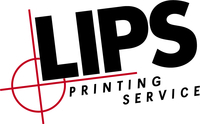We understand that the world of computers and print technology can be rather intimidating. So, here you'll find answers to common questions our clients ask. Start by selecting one of the links below.
If you don’t see what you need – call or contact us online.

- What kind of work does LIPS Printing Service do?
- What software does your design staff use?
- How do I go about getting an estimate from you?
- What file format should I use when submitting my artwork online for printing?
- Why do you need bleeds and crop marks?
- At what resolution should I save my photos and graphics?
- How can I send you my Design from Canva?
- How do I get a proof and view it?
- Why do the printed colors look different from the colors on my screen?
- Is white considered a printing color?
- How long does it take for you to complete my order?
- What is the Pantone Matching System?
- What is variable data printing?
- What do I need to provide for variable data projects?
-
What kind of work does LIPS Printing Service do?
Printing Services - Our store has the capability to meet your needs whether it’s digital printing, one-color to full-color printing, small to large printing amounts, we can offer a solution that will be just right for you.
Finishing Services - We can cut, perforate, score, number, fold, collate, saddle stitch, laminate, and more.
Design Services - We utilize the latest design technology available in order to offer a full range of design services. If you need artwork produced, we can work from the files you provide or design your project from scratch.
-
What software does your design staff use?
Our design staff utilizes a wide array of state-of-the-art software for designing as we have the Adobe Creative Cloud. The programs in Adobe Creative Cloud that we most commonly use are InDesign, Photoshop, Illustrator, and Acrobat. We also have access to Microsoft Office programs that include Publisher, Word, PowerPoint, and Excel.
-
How do I go about getting an estimate from you?
Well, since you are here, we would suggest you use our online estimate request form. Otherwise, the best way to ensure that we get all the information necessary to do an accurate quote, give us a call and talk with one of our customer service representatives at 308.234.2319.
-
What file format should I use when submitting my artwork online for printing?
The best way to send us your file is to create a PDF with the program you designed your artwork in. With the installation of a PDF print driver on your computer, virtually any program can generate a PDF file suitable for printing. Both commercial and free PDF print drivers are available online for download from different sources. However, you can also send us your InDesign, Photoshop, Illustrator files. Just make sure you either package your file/s or send us all the fonts and images you used to set up your artwork.
Click HERE for example of how to package your InDesign file.
Click HERE for example of how to package your Illustrator file. -
Why do you need bleeds and crop marks?
Bleeds are used when an image, text, or color blocks go to the edge of the document and the image, text, or color blocks should typically extend 0.125” past the edge of the document. The reason we need bleeds is that most printers can't print to the edge of the paper. So, to fix this we print on oversized sheets and then cut down your artwork to your required size using the crop marks. Crop marks are the lines that we use to align the cutting blade so we can cut down artworks to the size that is requested.
Click HERE for example of how to make your PDF have bleeds and crop marks with InDesign.
Click HERE for example of how to make your PDF have bleeds and crop marks with Illustrator. -
At what resolution should I save my photos and graphics?
Resolution should be set to high resolution or 300 dpi. Please do not send or use pictures and graphics pulled from the internet as these are often low resolution or typically 72 dpi. Please, avoid these pictures and graphics as they will appear pixilated and blocky once printed.
-
How can I send you my Design from Canva?
There are several different ways to get us your design from Canva. But the easiest way is to go to your project. Click on "..." that shows up when you hover above that project. Move your mouse down and click on Download. A new window will appear and you will need to select a different File type (NOT PNG). To select a new File type click on the PNG and scroll down to "PDF PRINT" as your file must be high quality. Once PDF PRINT is selected, checkmark the "Crop marks and bleed". Click on the purple "Download" and wait till your file is completely downloaded. Make sure to save your file either to your computer or device. Once your download is complete you can either submit it through our website or bring it in on a flash drive.
-
How do I get a proof and view it?
There are many ways to view a proof, but the most efficient and fastest is to have us email you a digital proof in PDF format. Other options include printing out a printed sample or even faxing proofs. Please just let us know what process you prefer; we will cater to you.
If your press printed material requires special care and consideration, just ask for a press check and we will go so far as to get you an actual printed sample off the printing press and make sure it looks exactly like you want.
We use extreme care in preparing material for our clients. We are human however so please do take the time to look over your proof, examining all aspects of it down to the smallest detail. If something is incorrect, we will fix it as it is much easier to fix something before it is printed than afterwards!
-
Why do the printed colors look different from the colors on my screen?
Monitors use the RGB (red, green, blue) color model, which usually supports a wider spectrum of colors. Printers use the CMYK (cyan, magenta, yellow, black) color model, which can reproduce most—but not all—of the colors in the RGB color model. Depending on the equipment used, CMYK generally matches 85–90% of the colors in the RGB model. When a color is selected from the RGB model that is out of the range of the CMYK model, the application chooses what it thinks is the closest color that will match. Programs like Adobe Photoshop will allow you to choose which color will be replaced. Others may not.
-
Is white considered a printing color?
Not typically. Because white is the default color of paper, it is simply recognized as the absence of any ink. However, if you want a type or graphic to be printed in white, we can do a reverse flood which is where we flood white paper with whatever color you want and leave the type or graphic in white.
-
How long does it take for you to complete my order?
Turn around time for most jobs is one week and often less. However, different jobs require different production times due to ink colors, paper stock, and many other uncontrollable variables. If you need a job in a rush, let us know and we’ll work it out.
-
What is the Pantone Matching System?
The Pantone Matching System (PMS) is a color reproduction standard in which colors all across the spectrums are each identified by a unique, independent number. The use of PMS allows us to precisely match colors and maintain color consistency throughout the printing process on LIPS Printing presses.
-
What is variable data printing?
Variable data printing is the technology for printing documents so that each piece is personalized to the specific recipient. At the most basic level, this means personalizing a name and address. But for real impact, many projects include unique graphics and content that speaks directly to the recipient.
-
What do I need to provide for variable data projects?
We work with many types of data files, but excel files are the safest bet. To save time and hassle, make sure your data is properly formatted with each piece of data in separate fields.
